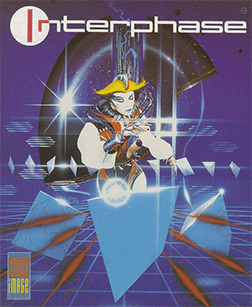Interphase (video game)
| Interphase | |
|---|---|
 Cover art for Interphase | |
| Developer(s) | The Assembly Line |
| Publisher(s) | Image Works |
| Platform(s) | Atari ST, DOS, Amiga |
| Release date(s) | 1989 |
| Genre(s) | 3D shooter and puzzle |
| Distribution | Floppy disk |
Interphase is a 1989 3D first-person and puzzle video game developed by The Assembly Line and published by Image Works for multiple platforms.
The developers were licensed to use concepts from Neuromancer, reflected in the virtual-reality cyberspace concept and theme of a powerful corporation.
The game is considered an early first-person shooter, pre-dating Catacomb 3-D and Wolfenstein 3D. However, the game primarily focuses on puzzle-solving using the interaction between a 3D cyberpunk environment and its conceptual relationship with a 2D zoomable blueprint in which a non-player character is indirectly guided through the floors of a high-security building.
Later games that have a similar style to the 3D elements in Interphase include Pyrotechnica and Rez.
Storyline
In a dystopian cyberpunk future, The Dreamtrack Corporation has cornered the entertainment market, selling DreamTracks, dreamed or imagined adventures and experiences which can be enjoyed by consumers. The player is Chad, a DreamTrack Dreamer who has discovered that Dreamtrack Corporation is using the DreamTracks to destroy people's minds. He decides to break into Dreamtrack HQ. To overcome the high-tech security systems, his girlfriend, Kaf-E, agrees to break into the building physically, while Chad enters a virtual reality world, inspired by Neuromancer, in order to hack into and disable the computer-controlled defences.
Gameplay
The action mostly takes place in two modes: a 3D cyberpunk environment and a 2D schematic map where puzzles are encountered. 3D objects in the cyberpunk environment represent objects such as security doors and cameras. To disable the real-world devices, the 3D objects must be destroyed. Puzzle-solving involves determining which objects to disable and in what order. The player must also deal with virtual defences, represented by enemy ships which pose a threat to the player's ability to jack in to the system, and which must be defeated.
While viewing the 2D schematic, the action in the 3D world continues, so it's essential that enemy ships have been dispensed with before puzzle-solving can proceed. Otherwise, the player becomes a sitting duck.
The game was ranked the 38th best game of all time by Amiga Power.[1]
Graphical style
.png)
The 2D environment is a polygon-based schematic closely resembling an animated blueprint. A very deep zoom-in is possible and necessary. The progress of Kaf-E and the positions of moving objects (e.g., security guards) and fixed objects such as cameras can all be monitored in this view.
The 3D environment is a first-person view from the front of a virtual ship navigating a multiple-level environment. The virtual levels do not represent the floors of the building, they simply represent parts of the computer system. Navigation between levels is accomplished by flying through square panels.
Platforms supported
The game runs on DOS, Atari ST and Amiga. On the PC platform it requires a 286 processor and VGA graphics.
See also
References
- ↑ Amiga Power magazine issue 0, Future Publishing, May 1991